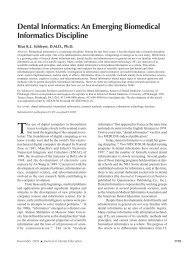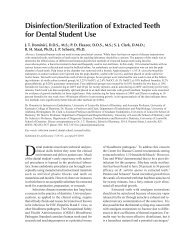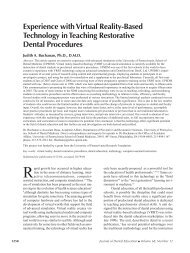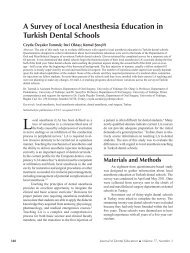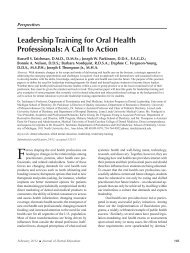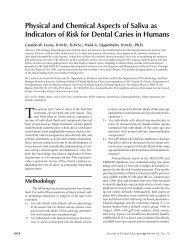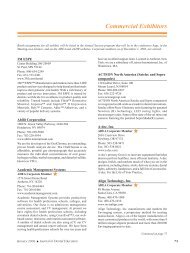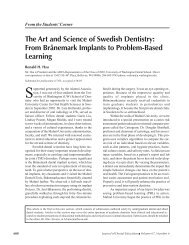List of Poster Presentations - Journal of Dental Education
List of Poster Presentations - Journal of Dental Education
List of Poster Presentations - Journal of Dental Education
You also want an ePaper? Increase the reach of your titles
YUMPU automatically turns print PDFs into web optimized ePapers that Google loves.
<strong>Poster</strong> Abstracts<br />
on selected images <strong>of</strong> each tooth. Student evaluation and feedback<br />
were performed through a Web-based survey. The digital images<br />
processed in this manner resulted in life-like 3-D images (object) <strong>of</strong><br />
a class II cavity prepared for amalgam restoration. These images could<br />
be rotated and viewed from any desired perspective. Moreover, images<br />
could be easily accessed, manipulated over the web or independently<br />
with a personal computer. The interactive module could be accessed<br />
by pointing at various areas <strong>of</strong> interest within the cavity, which in<br />
turn opened new windows with further information or diagrams. The<br />
preliminary results from student surveys indicated that 94% preferred<br />
VR-interactive 3-D images to two-dimensional pictures or sketches<br />
in textbooks. Seventy-one percent preferred viewing on the Web, and<br />
29% favored using a CD-Rom or other media.<br />
The 3-D virtual reality method is a convenient and innovative<br />
method to create interactive 3-D images <strong>of</strong> teeth prepared for various<br />
restorative procedures which have the potential to enhance studentbased<br />
education in restorative dentistry. (Supported by UBC TLEF<br />
#14S35809)<br />
8. A New Student-Centered Method for Teaching and<br />
Learning <strong>Dental</strong> Anatomy Using Virtual Reality<br />
Luu, Peter, University <strong>of</strong> British Columbia Faculty <strong>of</strong> Dentistry,<br />
Catherall, Jordan, University <strong>of</strong> British Columbia Faculty <strong>of</strong> Dentistry,<br />
Chehroudi, Babak, University <strong>of</strong> British Columbia Faculty <strong>of</strong> Dentistry<br />
<strong>Dental</strong> anatomy, in particular, deals with demonstration <strong>of</strong> threedimensional<br />
(3-D) objects that cannot be ideally illustrated in twodimensional<br />
figures or lecture slides. The purpose <strong>of</strong> this research<br />
was to investigate the feasibility <strong>of</strong> using 3-D virtual reality (VR) to<br />
enhance student-centered teaching approach in dental anatomy.<br />
Anatomically intact extracted teeth were collected from general<br />
dentists, Bureau <strong>of</strong> Legal Dentistry, and cadavers. Teeth were cleaned<br />
in bleach and mounted on an automated Kaiden VR-Rig. A total <strong>of</strong><br />
360 high-resolution digital images were obtained from each tooth as<br />
it rotated in the Y-axis and the camera circled from 0 (occlusal view)<br />
to 90 (buccal view). Images were collected at 10 intervals and stitched<br />
in QuickTime VR Authoring program to create a 3-D object movie.<br />
Anatomical reference points were marked and labeled on selected<br />
images <strong>of</strong> each tooth. All 3-D objects were saved as web-ready objects.<br />
Student evaluation and feedback were conducted through a Web-based<br />
survey. The digital images processed in this manner resulted in lifelike<br />
3-D images <strong>of</strong> teeth. These images could be rotated, magnified,<br />
or viewed from any desired angle. Navigation through the interactive<br />
module was smooth and could be achieved by pointing at various<br />
areas <strong>of</strong> interest on the crown or the root surfaces. There was no<br />
noticeable difference in the speed <strong>of</strong> image manipulation whether<br />
images were viewed through a high-speed Internet connection or<br />
directly with an average personal computer. The preliminary results<br />
<strong>of</strong> student survey indicated that 55% felt the 2-dimensional drawings<br />
and photos <strong>of</strong> dental anatomy textbooks were insufficient, or confusing<br />
21% , or not at all usable 15%. Ninety six percent <strong>of</strong> students preferred<br />
self-study sessions using VR-interactive 3-D images to the use <strong>of</strong><br />
dental anatomy textbooks.<br />
The 3-D virtual reality method is a convenient and innovative<br />
method to create 3-D interactive images <strong>of</strong> teeth that have the potential<br />
to enhance student-based education in dental anatomy. This method<br />
should be readily expanded to include other areas <strong>of</strong> dental education<br />
such as restorative dentistry (Supported by UBC TLEF # 14S35809).<br />
9. Implementation <strong>of</strong> a Youth Smoking Cessation<br />
Program: Not-On-Tobacco (NOT)<br />
Chong, Sherri Lyn W., University <strong>of</strong> Pittsburgh School <strong>of</strong> <strong>Dental</strong><br />
Medicine, Ganni, Mohamed A., University <strong>of</strong> Pittsburgh School <strong>of</strong><br />
<strong>Dental</strong> Medicine, Markovic, Nina, University <strong>of</strong> Pittsburgh School<br />
<strong>of</strong> <strong>Dental</strong> Medicine<br />
The purpose <strong>of</strong> this project is to determine the barriers and<br />
obstacles associated with establishing the American Lung<br />
Association’s Not-On-Tobacco program in an inner-city high school.<br />
In addition, the efficacy <strong>of</strong> this program will be assessed.<br />
Tobacco use is a habit that is started early in life and is very<br />
difficult to quit. According to a study in New York City, 1 in every 4<br />
youths reported smoking (1). Early adolescents, ages 11-15 and in<br />
the 6th -10th grades, are the most likely to try smoking for the first<br />
time (2). In addition, smoking rates among black students increased<br />
a drastic 80% between 1991-1997 (3). Even though reported current<br />
smoking rates are lower among black (22.7%) and hispanic (34%)<br />
youths compared with white youths (39.7%), it is imperative to<br />
develop effective strategies <strong>of</strong> prevention and intervention, as they<br />
comprise the fastest growing population in the United States (4,5).<br />
The risk <strong>of</strong> oral cancer increases with the amount and time one smokes,<br />
while the risk is decreased following smoking cessation (6). In the<br />
United States, nearly 1 in 3 people with oral cancer die with or as a<br />
result <strong>of</strong> their disease (7). Smoking has been shown to be responsible<br />
for 75% <strong>of</strong> the oral cancers in the United States (6). Cigarette smokers<br />
also have a 2 to 5 times higher risk <strong>of</strong> oral cancer than nonsmokers<br />
(6). Early detection from dentists, through oral cancer screenings and<br />
smoking cessation education is essential. Although dental health care<br />
providers are the ones who should be providing these services, it has<br />
been found that only 24% <strong>of</strong> current smokers and 18% <strong>of</strong> smokeless<br />
tobacco users reported that their dentist had advised them to quit<br />
smoking (8). Based on this information, we are implementing the<br />
American Lung Association Not-On-Tobacco program, a voluntary<br />
10-session gender-divided class. It is predicted that this program will<br />
reduce smoking among the high school students. Major contributing<br />
factors to the success <strong>of</strong> the program include the timing <strong>of</strong> the program,<br />
enthusiastic school support, high session attendance, and effective<br />
recruitment methods.<br />
Citations<br />
1. Siqueira L, Diab M, Bodian C, Rolnitzky L. Adolescents Becoming<br />
Smokers: The Roles <strong>of</strong> Stresses and Coping Methods. J. <strong>of</strong><br />
Adolescent Health 200;27: 399-408.<br />
2. Preventing Tobacco Use Among Young People: A Report <strong>of</strong> the<br />
Surgeon General. Atlanta: U.S. Department <strong>of</strong> Health and Human<br />
Services, Public Health Services, Centers for Disease Control and<br />
Prevention, National Center for Chronic Disease Prevention and<br />
Health Promotion, Office <strong>of</strong> Smoking and Health, 1994.<br />
3. Centers for Disease Control. Youth Risk Behavior Surveillance-United<br />
States, 1997. MMWR Morb Mort Wkly Rep 1998; 47: SS-3.<br />
4. Day JC. Population Projections <strong>of</strong> the United States by Age, Sex,<br />
Race and Hispanic Origin: 1995 to 2050. U.S. Bureau <strong>of</strong> the<br />
Census, Current Population Reports. Washington,DC: U.S.<br />
Government Printing Office, 1996: P25-1130.<br />
5. Tobacco Use Among U.S. Racial/Ethnic Minority Groups African-<br />
Americans, American Indians and Alaska Natives, Asian Americans<br />
and Pacific Islanders and Hispanics: A Report <strong>of</strong> the Surgeon<br />
General. Atlanta: U.S. Department <strong>of</strong> Health and Human Services,<br />
Public Health Services, Centers for Disease Control and Prevention,<br />
National Center for Chronic Disease Prevention and Health<br />
Promotion, Office <strong>of</strong> Smoking and Health, 1998.<br />
6. Winn Dm. Tobacco Use and Oral Disease. J <strong>of</strong> Dent Educ 2001;<br />
65: 306-312.<br />
7. Johnson N. Tobacco Use and Oral Cancer: A Global Perspective.<br />
J <strong>of</strong> Dent Educ 2001: 65: 328-339.<br />
8. Gordon JS, Severson HH. Tobacco Cessation Through <strong>Dental</strong><br />
Office Settings. J <strong>of</strong> Dent Educ 2001; 65:354-363.<br />
9. Reducing Tobacco Use: A Report <strong>of</strong> the Surgeon General. Atlanta:<br />
U.S. Department <strong>of</strong> Health and Human Services, Public Health<br />
Services, Centers for Disease Control and Prevention, National<br />
Center for Chronic Disease Prevention and Health Promotion,<br />
Office <strong>of</strong> Smoking and Health, 2000.<br />
260 <strong>Journal</strong> <strong>of</strong> <strong>Dental</strong> <strong>Education</strong> ■ Volume 66, No. 2



